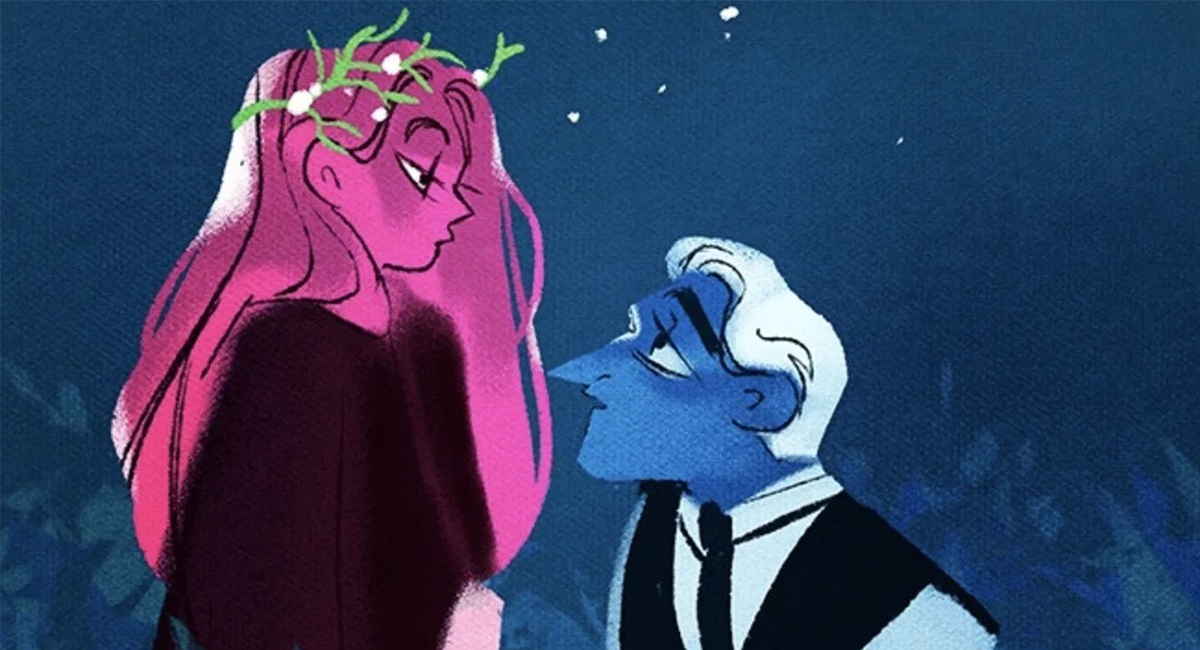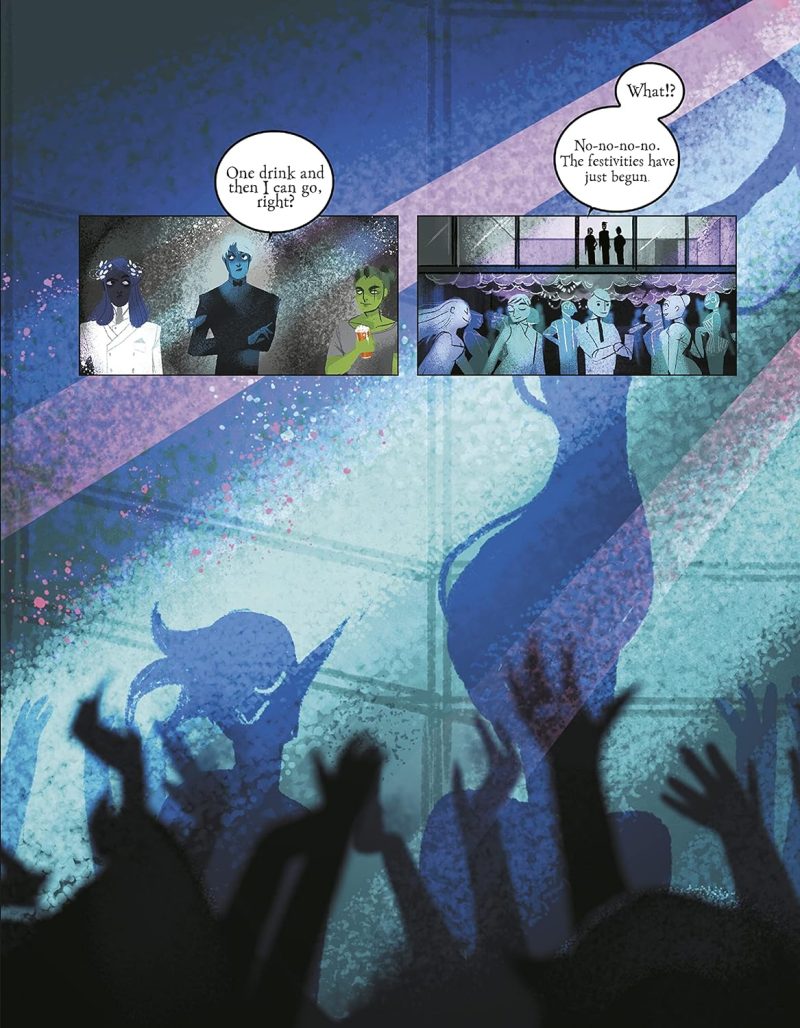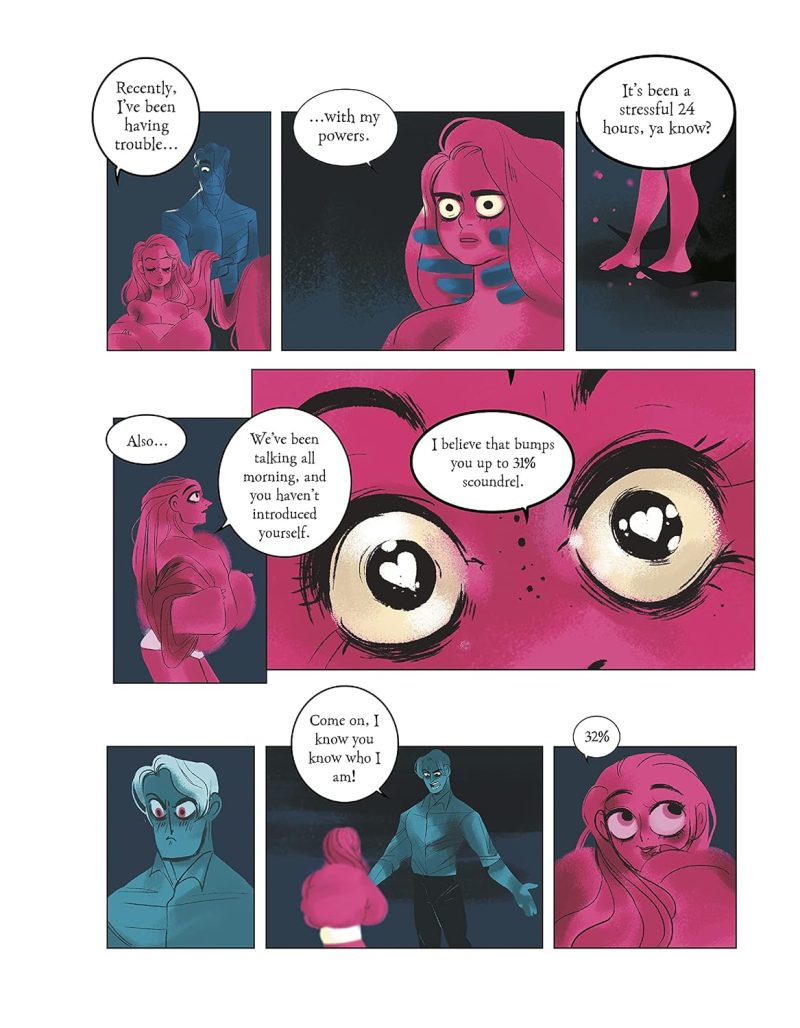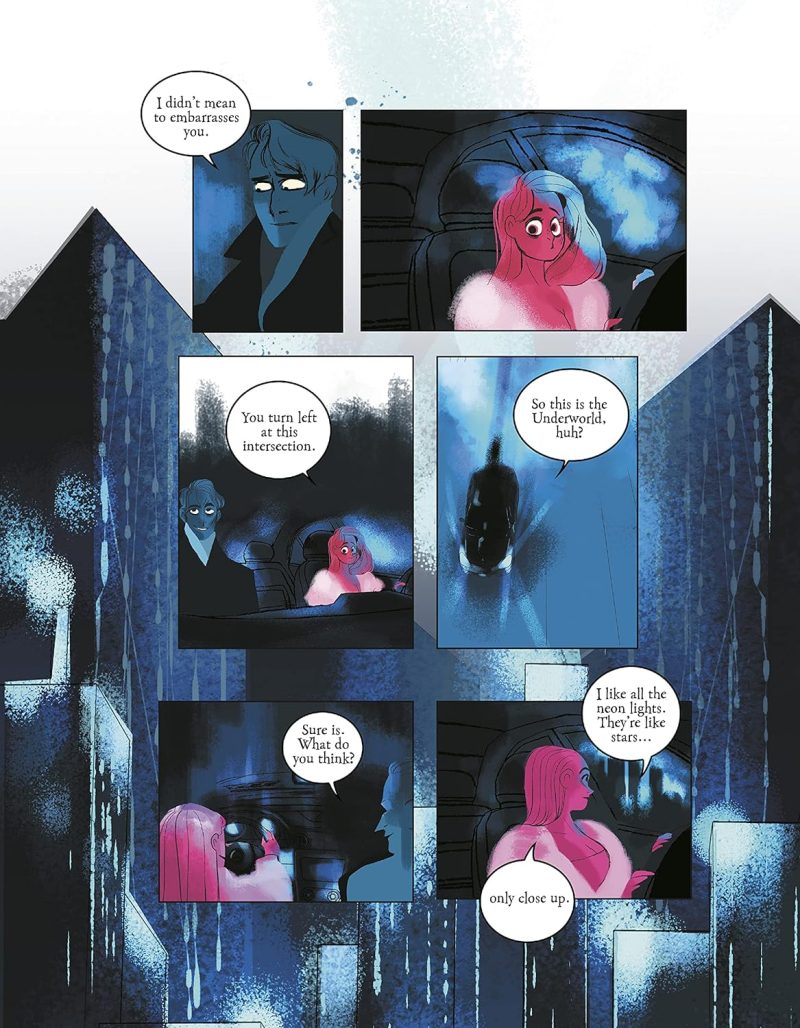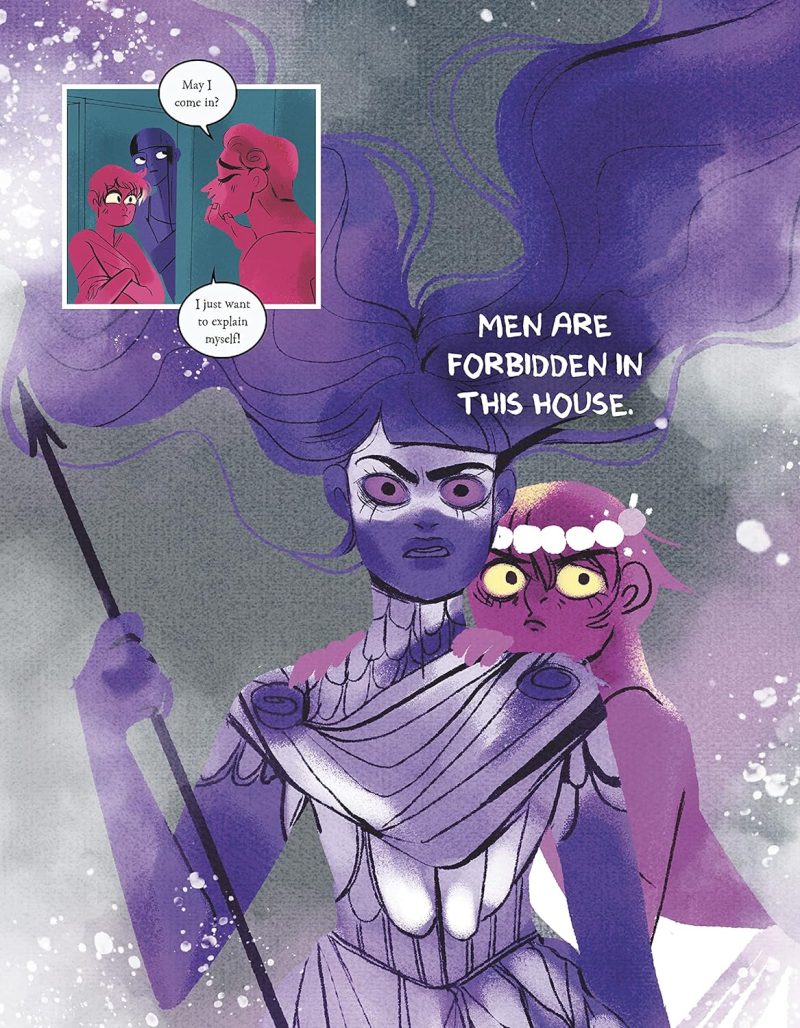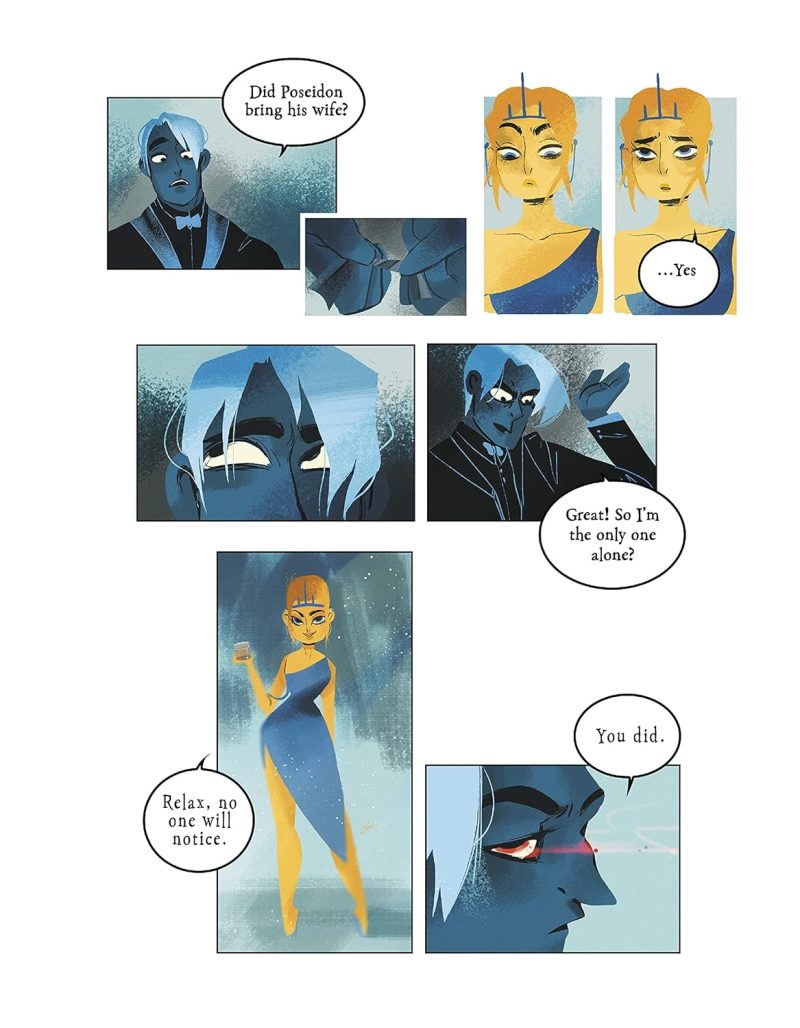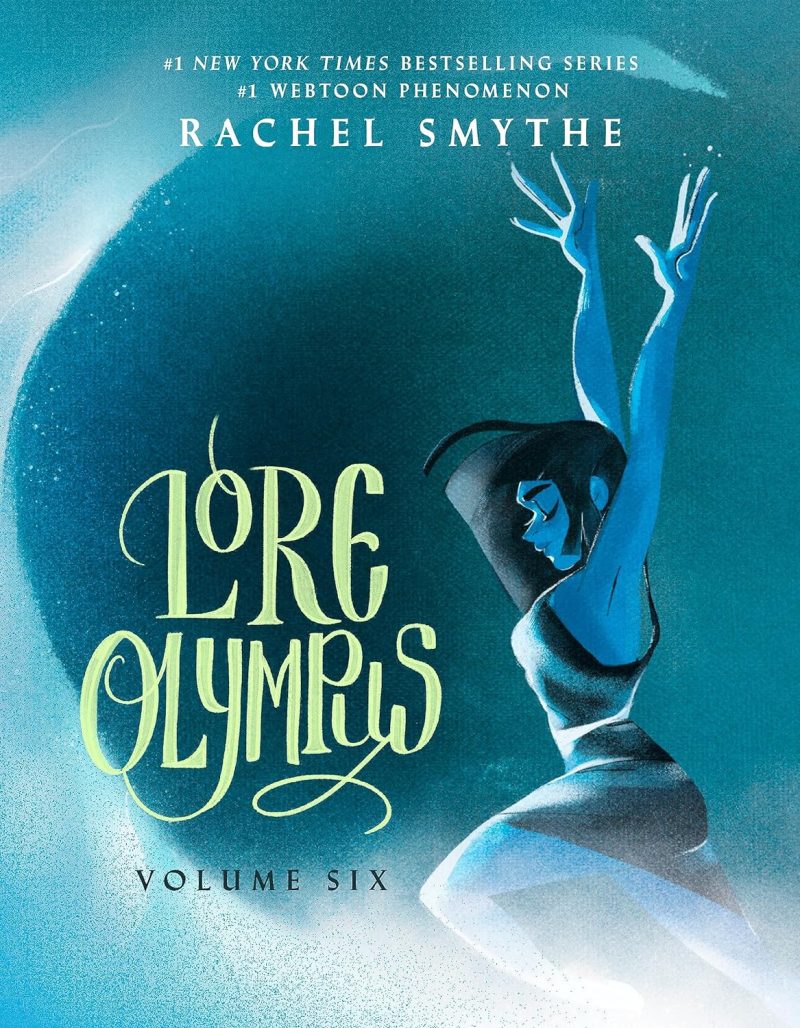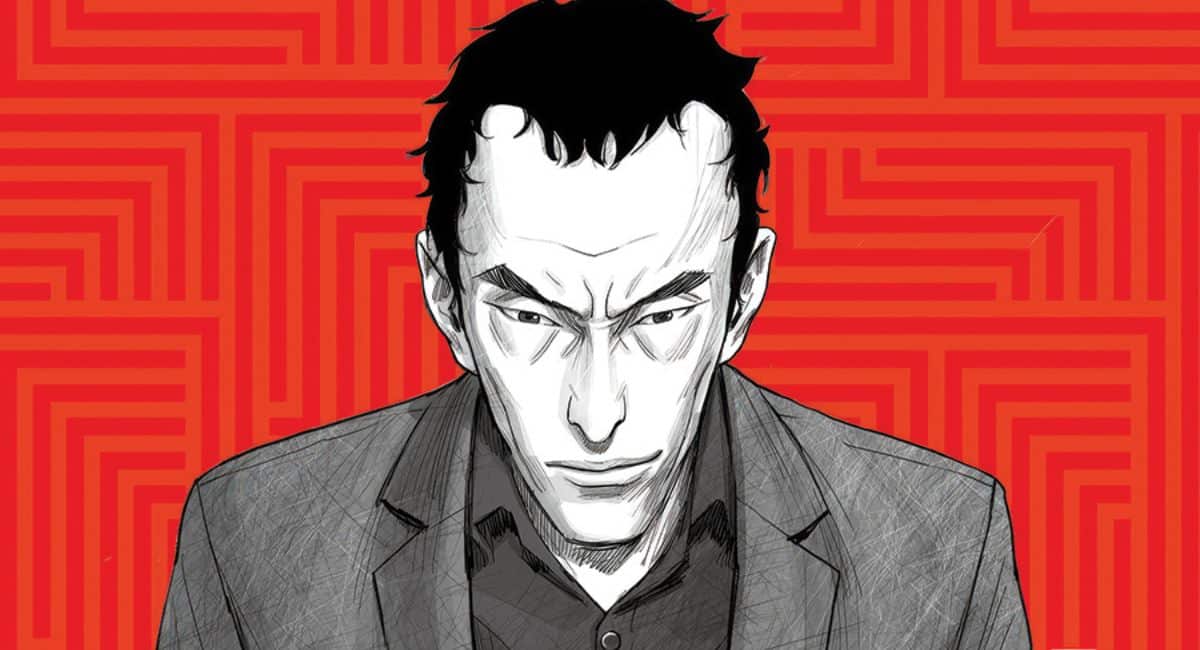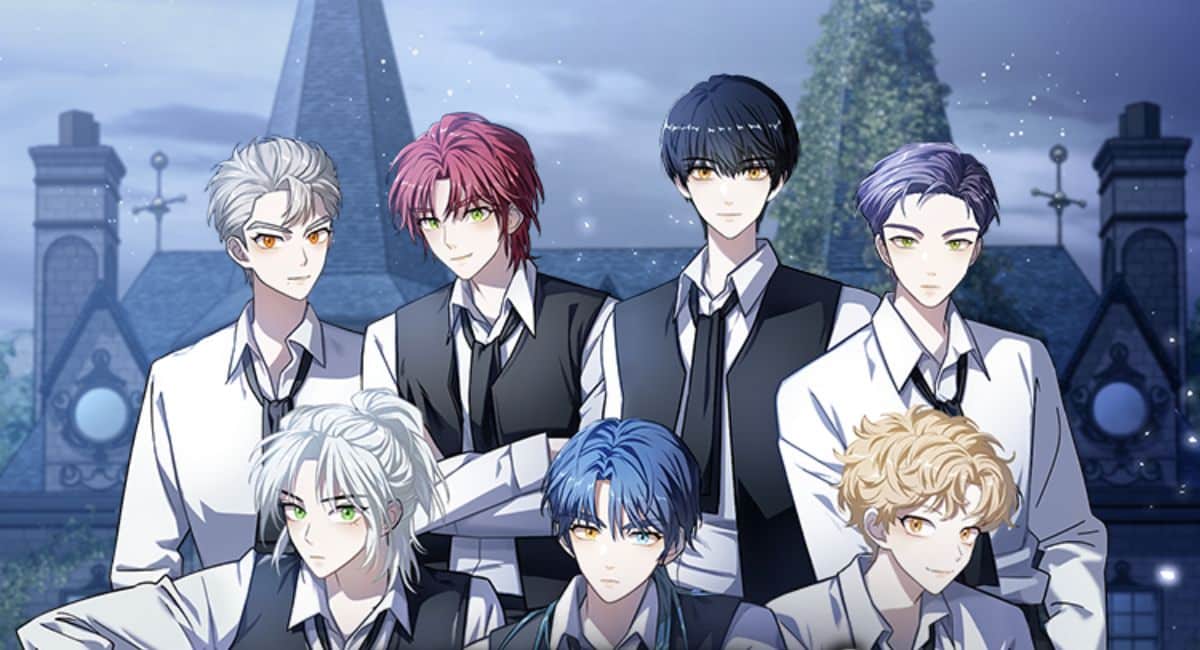Rachel Smythe, creator of the internationally successful webtoon Lore Olympus, has made her very first appearance at New York Comic Con 2023. Lore Olympus is a bestselling, award-winning WEBTOON series that retells the mythical romance between Hades, the Greek god of the Underworld, and Persephone, the goddess of Spring. It boasts a staggering 1.3 billion views, 6.4 million follows, and an overall site rating of 9.64 out of 10 from its readers on WEBTOON. It is published digitally on Naver’s WEBTOON platform, and five volumes are currently available in print by the INKLORE imprint of Penguin Random House, with over 2.1 million copies sold to date. The series has been translated into 13 languages and is sold in 15 territories worldwide. More accolades include:
2x Winner of the EISNER AWARD for Best Webcomic, 2022 and 2023 2x Winner of the HARVEY AWARD for Digital Book of the Year, 2022 and 2021 Winner of the RINGO AWARD for Best Webcomic, 2022 HUGO AWARD Nominee for Best Graphic Novel, 2022 3x EISNER AWARD Nominee, 2023, 2022 and 2019 3x HARVEY AWARD Nominee, 2023, 2022, and 2021 Winner of the GOODREADS CHOICE AWARD for Best Graphic Novel, 2021 Winner of the ALA ALEX AWARD, 2021 RINGO AWARD Nominee for Best Webcomic, 2020
At this year’s NYCC, Smythe held autograph sessions, participated in two panels, and held a media roundtable that The Beat was invited to. Below is a transcript of the conversation between Smythe and other invited journalists, including our own Marion Pena.
SMYTHE: So I’m working on an exciting new project in Britain with Penguin Random House and Del Rey. It’s called Rachel Smythe Presents. It’s basically celebrating the creators who do work based on mythology and help bring these stories to life. That’s really exciting. I can’t wait to get started.
Q: Is it alright to have some follow-up questions about that?
SMYTHE: Yeah, you can.
Q: Okay, so to follow up on that while it’s fresh: other creators touching on mythology; do you mean mythology outside of the Greco-Roman pantheon? From anywhere, basically?
SMYTHE: Yes. At this stage, it’s very early beginnings. So you know, we haven’t made those complete decisions yet. But yeah, it could be Greek mythology, but also mythology in general. That’s what we’re going for.
Q: I love that, I’m so excited for that. Actually, that brings me to my first question I have for you. When did your love for mythology start?
SMYTHE: So I liked it for a really, really long time, maybe since childhood? I think my introduction to it is really similar to a lot of people. So Disney’s Hercules came out when I was maybe a middle schooler, but I don’t know for sure because the education system is different here. But it came out, and I watched it. I was very fond of it, and loved it very much. Of course, we then see people who see something they like, and they need to research it a lot.
Me and my sister were very much into it. When we learned that Hades had a wife, I was like, “He has a wife, Why wasn’t she in that movie?” But she was actually in the movie—she’s like, in the background having a giant cocktail. Yeah, if you look at the beginning bit of it, she’s got a drink. A cocktail. Like that’s that big (gesturing). Like, baby, look out. She’s talking to some giant green man. But yeah, I loved it and researched it as a kid, and just consumed as much as humanly possible. And the rest is history!
Q: What do you think it is about Hades and Persephone that keeps people coming back to this trope, to this story? I’m obviously a very big fan of them as a couple in this kind of relationship. So what do you think it is about them?
SMYTHE: I think with Hades and Persephone, particularly with the source material, it really lends itself to adaptation. There’s a lot of things that you can infer from reading it. So I don’t want to do the stories a disservice by saying that they’re not detailed, because of course they are, but they like to prioritize different things since they’re from a different time. And I think, oh, gosh, it’s very versatile in terms of retelling. There’s a lot of ways that you can take it, ways to interpret it. It’s a beautiful feminist story about a mother facing bureaucracy, misogyny and patriarchy, and getting her daughter back. So that’s a great story!
But it can also be a tragic romance. It’s just very dynamic. There’s a lot you can do with it. I personally like going back to my childhood; I remember reading about it and thinking, what was Persephone’s day like? What did they do, what did they talk about? Where’s her closet? How many outfits did she have? Did they like each other? Didn’t they like each other? Maybe they liked each other later. There’s a lot you can do, and it’s really fun. Even if I had to do it over it differently. I’d say, yes, I can, but different! I could, I just love the stories. It’s great.
Q: Are there any other myths that you thought about retelling before Lore Olympus?
SMYTHE: That’s a good question. Give me a sec, because I know that I have. It’s not a myth, so much as a fable, or grim story. The Goose Girl, which if you’re not familiar with The Goose Girl, she’s a princess. She’s got a handmaiden and they have to travel somewhere for some particular reason. Then on the way there, her handmaiden steals her identity. Like she kicks her in a creek or something, I don’t know. She’s like, “You’re done,” (grunts) and basically takes over and turns to her betrothed and she’s like, “I’m the princess!” It’s great. I think it’s hilarious. The little goose girl, I think she gets called that because she looks after geese—that’s her job she does. You’re meant to root for the Goose Girl, but I’m thinking, “She is a princess.”
To me, I’m really compelled by the opposite end of this identity theft story. But the point of this story, the story is actually about being very good. Because I think that Goose Girl says, “I’ll work hard on a farm and whisper my secrets to an oven?” And then the oven feels sorry for her. I don’t know, it’s been a while. Look out for it. It’s very funny, I like this story. It’s great. Gosh, I know there’s others. But I’m having a brain meltdown today. There’s so many of them to work with. No, I think that’s the one that I really like.
I’ve been learning a little bit more about Norse mythology, but not the kind we all know, like Loki and Thor—they’re very ubiquitous, and everybody knows them. But ones more based on Vikings. Like just a little bit divorced from that. It’s a little harder to research, but they’ve got some great kind of warrior woman adventure stories, which I’m having a hard time remembering; the exact names and titles. But they’re very beautiful. With lots of magical jewelry, which I enjoy. I feel bad because I can’t say anything right now. But something like that would be great, yeah.
Q: Given the five or so years that you’ve been working on Lore Olympus, have you found anything in your approach to this kind of adaptation that has changed since you first set out on it?
SMYTHE: I think in the beginning I was more… One of the things about mythology is it does really lend itself to creating a structure to a story. Because having a whole new story can be very daunting. I think in the beginning, I really leaned on that. But going forward, I thought I can be much more liberal with it. Because after all, I’ve never intended Lore Olympus to be beat-for-beat, authentic retelling… you know, honoring the spirit of things, if you will. But I think there’s things wrong, like Hades; when he’s in the underworld after Persephone goes there, when she eats the pomegranate seeds. Or sometimes, eating the food there [in the Underworld] causes you to stay there.
So well, why is Hades different in this case? How did he just go there? How was he just fine? So it was really interesting to build in some mechanics into the story that would show what would happen to him when he went there, like how come he’s tied there? So that was really interesting to explore. Also, revisiting what would happen when eating the seeds and how that affects the story specifically. So I think, in terms of adaptation, that’s really fun to try out something new, because everyone knows the original stories.
And for me, what’s fun about it is that I really love the idea of people seeing something that I’ve made and learning about Greek mythology, and then going and checking it out the same way that I did with Disney’s Hercules. Which again, is not completely faithful to the original stories, but Disney’s not going to have a full scene of Zeus running around heaven having affairs. Like they can’t, there’s no family-friendly or the planets aligning and all that kind of thing. But yeah, I watched it, enjoyed it, and then learned about the source material, you know, and I think that’s like a great thing. Yeah.
Q: The art from Lore Olympus really stands out for its vibrance, it’s quite beautiful. How did you decide which colors would represent each character?
SMYTHE: So for me, I look at what you can do in terms of storytelling. So a lot of the peers have contemporary color matches. Hades is blue, Persephone is pink. So together, it looks very nice. Also, the whole of the underworld–the environment–is all blue. When Persephone goes there, she sticks out and it’s very vibrant. Also when Hades goes to Olympus, with the pastel tones, he sticks out. It’s like that sort of mechanic for characters like Ares. He changes his color when he’s angry.
This is slightly based on one of my friends; she had a baby who was a redhead. You know how babies have no eyebrows? You can tell when her baby would get upset, because you could see that the eyebrows were sitting in and they got all red before she would get upset. So that’s why Ares is an orangey, sort of rusty color. But as he gets more upset, he gets more and more red. Sometimes it’s dysfunctionality, things like that.
Q: One of the things I love about the world is that it is unafraid to tackle heavy topics. So obviously, that comes with its own challenge. But were there any arcs or beats or moments that aren’t inherently tough to tackle that you’ve personally found? Unexpectedly tricky, I guess.
SMYTHE: What is difficult in terms of storytelling… I don’t know if this is a direct answer. But this is something that I struggle with. You have to keep the story interesting and fresh, especially when it’s a long-format story. You have to make lots of cliffhangers and things to entice people to come back. One of the ways is introducing new stories and threads, and then later on resolving them by tying them up in a way that’s elegant or satisfying to people, and semantically correct. I think that’s probably one of the hardest things I’ve ever done.
In terms of the end of Lore Olympus, I’ve always known what that was going to look like. But with a long format story, you kind of have to refine it over time. Because sometimes you reach a point, and you think, “This no longer makes sense to me. I don’t think it’s actually as satisfying as I thought it was going to be.” I think with endings, you really have to try your very best for people. Because I know this is what people will remember a lot about the series. I put so much effort into the end of mine. It’s taken a lot out of me to do. But now I think, “Yes, it’s good. I worked really hard on it.” It’s one of the biggest challenges of my life.
Q: Earlier you were mentioning the pomegranates, which is a huge component of the story. And something very unique about the way you tell the story is that there is a tone of agency with Persephone choosing to do this. What about that theme of agency was important to you?
SMYTHE: I think for me I think it’s good to honor Persephone as a character in the story, a huge part of her growth as a character is learning to have agency. Based on the content of the story of what we already know, I think it would be doing her a disservice to have some level of—not trickery, because I don’t think that’s like the correct word—but just her not having a choice later on, I feel like it would be a bit of a step back. Not that that’s necessarily a bad thing, because I believe that not all development should be linear. But it was such a major moment, it had to be, you know, a choice! And it had to be growth. So that’s how I arrived there.
Q: I’m curious about the creative choice to have sort of the realm of the gods be sort of a parallel to our present day. Because when they go to the mortal world, it’s sort of the time period we think of when we think of mythology. So I was just wondering, what inspired that, that creative choice and that the disconnect between the two are not that separate.
SMYTHE: Worlds? That’s a good question. For me, it’s a couple of factors. One is obviously, I love Greek mythology. So it feels like a missed moment to not have those ancient world references. I’m kind of having my cake and eating it too, because I get the fun of the modern world. But I also get to research all of the historical fashion and buildings and play with those sorts of things. It can potentially help contextualize some of those more historical traditions of sorts, and see how they might translate over into the modern setting.
But also, when you read these stories, there’s a few things that get brought up. If a model were to see a God, they would die, because it would be so spectacular. Like her body crumbles apart when she sees Zeus and his true form. It’s interesting, you know, if these mortals were to see the modern Olympus. They’re probably not understanding what they were looking at. It would be fair to say that the gods would not share technologies, but to me, it makes sense. Yeah. I love that.
THE BEAT: Since you’ve had the ending in mind for a while, what would you say is one of the most satisfying detours you took along the story? Maybe an event that you didn’t really think would happen, but it just did because of the characters?
SMYTHE: Ooh, that’s a good one. I’m really bad at measuring, so if you were to take me to a country fair, and they had the Jelly Bean guessing game, and you were to ask, “How many jelly beans are in there?” I’d say, “Like 10.” Then they’d say try again. And I’d answer “a million.” I just can’t do it! So this was planned, but it took way longer than I thought it was going to. There’s a bit with Persephone where she goes to stay at Hades’ house, but that went on for a really long time. I was thinking, “Yeah, she’s just gonna be there for like three episodes, tops.” But I think it’s like at least 15 for a while. So I enjoyed it. It was fun. It was a good, cozy time in the story before it was upsetting. It’s fun.
Q: Did you always intend for the format of Lore Olympus to be comics? And if so, what was it about comics that lent to tell your story?
SMYTHE: Writing is definitely not my first strength, it’s definitely the drawing component. All the time, I wonder, “How did I do this?” I don’t know, and it’s so scary. At the time, in the beginning, when I first started out, I thought that even the concept of making 20 chapters—I didn’t know if I had it in me! The art definitely came before the story sometimes when I’m doing like a big doodle. Very technical training, like a lot of that process, will actually give me the writing ideas. It’s sort of like art first and then writing. But now I will have gotten the hang of it a bit more. So now I can actually write an outline without doing the drawings. So it’s been a good learning experience.
Q: So no spoilers, obviously. But are there any sort of stories, myths, characters that you wanted to touch on that you haven’t yet or that you just won’t have time to do for the [main] story?
SMYTHE: That’s fine. I think one of the things that I try to be conscious of is that I love all of my supporting characters equally. And I wish that everyone else loved them, too! But not everyone wants a massive side quest about different characters. I do think it’s important to say “Here’s the supporting characters, and this is what’s happening to them,” because they help enrich the story. And also give a bit of breathing room. But it’s a difficult balance of learning when to draw that line when people say “I don’t know who these characters are, and I don’t really want to participate with them right now.” But it’s fine, you like what you like!
I think one of the things that I would have done, had it made sense—there’s no easy way to put it in at this point—was supposed to be like an expedition to Poseidon and his ocean-like world. They wanted me to do some stuff in the ocean world. But I’m like, “I just don’t think there’s a good place to fit it in.” But never say never, you know. I can always come back and do it, later on. It was just something where I thought, “Oh, yeah, that throws off the pacing.” Unfortunately, we never got to go to the ocean kingdom and see what it’s like. It’s very chaotic. It’s very, “nobody’s doing the dishes, or doing laundry.” But everyone’s very chilled out.
THE BEAT: Were there any cultural differences you were aware of when you were drafting your story? Did you feel that maybe things might have to be touched up for modern tastes? As in taking Greek myths, and adapting them into a modern story.
SMYTHE: Yes, that’s very hard, because Greek mythology is very universal. It’s the backbone of Western storytelling, and ubiquitous, but a lot of it is very dark. Even particularly with the adoption of Persephone. If I were to tell that story beat-for-beat, people would be like, “Ma’am, you need to get off the internet. Your Twitter handle and everything, you need to go.” [Laughs]. Like you gotta get out, because I think some people are like, this isn’t accurate. Like, did you want incest? You do have to take some leave from others and, you know, someone else can do this. Yeah, you get my drift.
Q: Something I really love about Lore Olympus is your fashion choices for Persephone. So how do you choose what outfits you’re going to put her in, and what did they represent for her journey?
SMYTHE: Thank you. I love picking out clothes for her. And I mentioned before how a character’s growth isn’t necessarily linear. In the beginning, she’s wearing a lot of white. There was sort of a structure with it in the start, in the sense that Hades is wearing a suit all the time; specifically, he’s always wearing white. So they could potentially get married at any point. They look like they’re coded to be a bride and groom. Because initially, I just recalled that this story is about marriage, and it’s important in some regions of ancient Greece. I’m told that it’s like a marriage story in some areas. So I thought, “I’m gonna honor that part of the story.”
But in terms of Persephone’s growth you’ll see later on in the series, she starts to wear way more green. Then later on in the arc that we’re currently having, she’s wearing a lot of blacks and dark blues, but occasionally she will still wear some pastel colors. For me, it’s about keeping a balance because I don’t think that Persephone should have to give up whole elements of her identity. It’s important for me to mix those different color palettes in, but in terms of silhouettes, I tried to pick things that are classical and have A-line cuts. This is so that they age very well. So they’ll look good in 10 years’ time, and not all of the fashion will look like that—some of it will become terribly dated—but it’s basically me in an effort to future-proof some items.
Q: Earlier, you mentioned having the light moments before all the heartbreak, which I think exemplifies Lore Olympus; we’re laughing, and then we’re crying. What is your trick, to manage that give and take, the balance between the two?
SMYTHE: I think it’s a cultural thing to do with New Zealand. We’re very, “you’ve got to laugh in the face of evil,” like a lot of our jokes are dark. Like a, “We’ll be having a terrible day, haha!” kind of thing. So I think we really understand it where I’m from. It just feels like a very natural thing to do, where sometimes something bad will happen, and in an effort to balance it out, we’ll find a way to laugh at it. That is just something that comes through naturally to me.
I think there are times when I’m like, “Is this appropriate to put a joke in here?” Because I don’t want to be insensitive, but for me personally; I feel like I always manage everything with humor. I think that works for other people. But yeah, levity is hard. It’s a hard balance for sure. Have I always made the right call? I’m not sure. But I do try, yeah.
THE BEAT: Is there a myth that you feel you would be up for remixing or retelling?
SMYTHE: In terms of a myth, I think I remember it now. I really like The Odyssey, of course. But I really want to do something from Penelope’s point of view. I think someone has already got it, like a previous version. I would really love to do a comedy about Penelope. Because I love that woman so much. That would be fun. So if I could, that’s what I’d do. Thank you. It was lovely meeting you all and thank you so much.
Lore Olympus Volume 6 will be available in hardcover and paperback on May 7, 2024!


